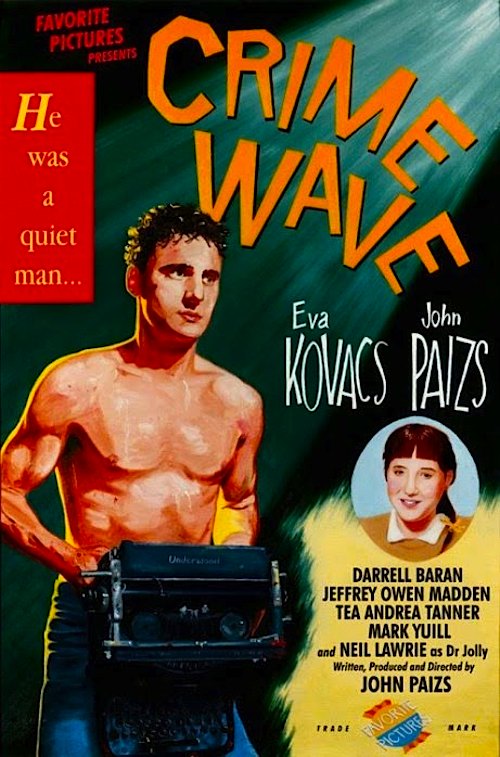By Joe Bendel. In Winnipeg, they don’t care for black-and-white film noir. They prefer “color crime movies.” It is a strange city, as viewers should know from Guy Maddin’s My Winnipeg. Although Maddin is much better known today, John Paizs provided the Winnipeg auteur his early inspiration. One can see a kinship in their films, but Paizs’ magnum opus is truly singular unto itself. Color crime dreams turn into nightmares in Paizs’ Crime Wave, which has a special revival screening this Sunday at Anthology Film Archives.
Steven Penny is a shy loner, who rents a room from Kim’s parents above their garage. For some strange reason, the pre-teen becomes fascinated with their lodger and his ambition to write a great color crime screenplay. Each draft of Crime Wave he writes starts and ends the same way. Some eccentric field of employment (like celebrity tribute performers or self-help gurus) is dominated by a small clique that pretty much “has the racket sewn up,” until a brash upstart “from the north” blows into town “with a dream.” Apparently, they commence some sort of crime spree to usurp the competition, but just when they are poised on the brink of success, they are brought down by a violently confrontation.
 How does Penny get from the beginning to the end? Unfortunately, he does not know either. Try as he might, he just can’t write middles. The frustration takes a toll on his psyche, even though Kim tries her best to be encouraging. In fact, he seems increasingly uncomfortable with her obsessive attention. However, when she finds him a potential screenwriting mentor in Kansas, the film really veers out into strange, dark territory.
How does Penny get from the beginning to the end? Unfortunately, he does not know either. Try as he might, he just can’t write middles. The frustration takes a toll on his psyche, even though Kim tries her best to be encouraging. In fact, he seems increasingly uncomfortable with her obsessive attention. However, when she finds him a potential screenwriting mentor in Kansas, the film really veers out into strange, dark territory.
With characters eventually interacting with their failed author, Crime Wave is more in the tradition of Borges or Pirandello than the early color melodramas it ostensibly spoofs. It is often quite funny, especially the successive takes of Penny’s middle-less screenplay we watch play out. Yet, there is something rather sad and slightly unsettling about Paizs’ taciturn performance as Penny. It is hard to describe the eccentric chord he strikes, but it is certainly distinctive.
The look of the film is also perfect in a perfectly idiosyncratic way. Whatever cameras and filmstock Paizs used aptly evoke the look of 1960s educational films as well as the contemporaneous color work of Douglas Sirk and Roger Corman. It is easily one of the most self-referential, postmodern films of the 1980s, but its sensibility not so far removed from a sketch comedy show like The Kids in the Hall, where Paizs did some segment directorial gigging.
It is really amazing how completely insane yet tightly controlled Crime Wave really is. It is clearly the work of a mad auteur that must be experienced from start to finish to truly get its scope and vibe. For obvious reasons, it has become cult favorite amongst Canadian cineastes. It is well worth seeing under any conditions, but especially when Paizs answers post-screening questions this Sunday (11/2) at Anthology Film Archives, because there are sure to be many and the answers will likely be a little odd. Indeed, Crime Wave is definitely recommended for color crime fanatics as a memorable way to wrap-up the weekend.
LFM GRADE: B+
Posted on October 30th, 2014 at 12:13pm.